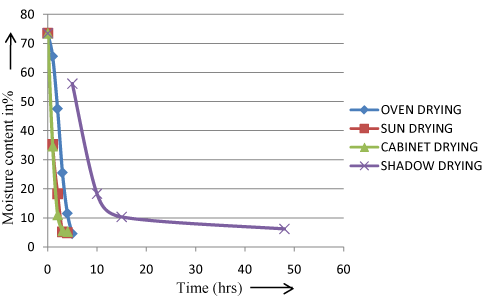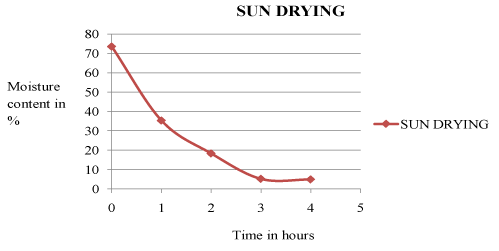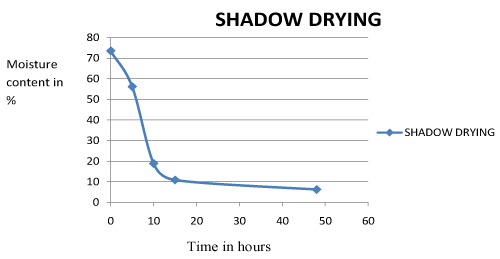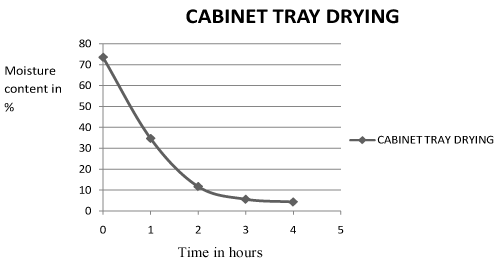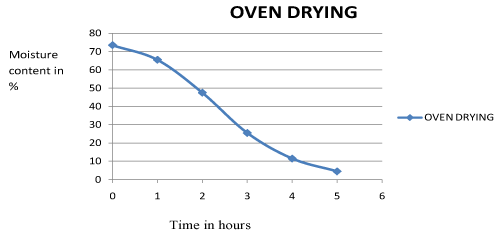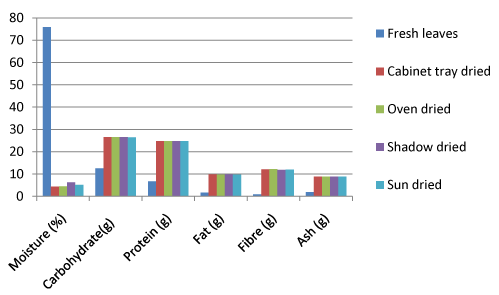| Research Article |
Open Access |
|
| Satwase A N1*, Pandhre G R2, Sirsat PG2 and Wade YR2 |
| 1Department of Food Science and Technology, MGM College of Food Technology, Aurangabad 431003 (MS), India |
| 2Department of Chemical Technology, Dr. Babasaheb Ambedkar Marathwada University, Aurangabad (MS), India |
| *Corresponding author: |
Satwase A N
Department of Food Science and Technology
MGM College of Food Technology
Aurangabad 431003 (MS), India
Tel: +919096729559 (R)
E-mail: satwaseamarjeet@gmail.com |
|
| Â |
| Received November 28, 2012; Published December 26, 2012 |
| Â |
| Citation: Satwase AN, Pandhre GR, Sirsat PG, Wade YR (2013) Studies on Drying Characteristic and Nutritional Composition of Drumstick Leaves by Using Sun, Shadow, Cabinet and Oven Drying Methods. 2:584 doi:10.4172/scientificreports.584 |
| Â |
| Copyright: © 2013 Satwase AN, et al. This is an open-access article distributed under the terms of the Creative Commons Attribution License, which permits unrestricted use, distribution, and reproduction in any medium, provided the original author and source are credited. |
| Â |
| Abstract |
| Â |
| The preservation of green leafy vegetables was very important. The leaves of Moringa oleifera have various uses in human life. Moringa oleifera leaves can be used in various foods like soup, sauces and it also used for medicine preparation. In present investigation the efforts have been made to prepare powder of Moringa oleifera by applying drying technique viz. Sun drying, Shadow drying, Cabinet drying and Oven drying. The drying was done at 60°C to minimize the drying losses. The results obtained from cabinet dried sample were better than other and it had highest nutrient retention followed by shadow, sun drying and oven dried sample. The rehydration ratio calculated at 55°C, 65°C, 75°C temperature for 60, 45, 30 minutes respectively. The rehydration ratio of cabinet dried sample was more than other samples. The study revealed that the cabinet tray drying method was observed suitable for dehydration of drumstick leaves. |
| Â |
| Keywords |
| Â |
| Moringa oleifera/Drumstick leaves; Sun drying; Shadow drying; Cabinet drying; Oven drying; Rehydration ratio |
| Â |
| Introduction |
| Â |
| Drumstick leaves (Moringa oleifera) is one of the most useful tropical trees. Presently, one of the most important trends in food and pharmaceutical industries is the growing demand for valuable natural sources of nutritional compounds. Green leafy vegetables are good sources of vitamins and minerals [1]. The leaves are also free of anti nutritive factors such as phenols, tannins and saponins [2]. |
| Â |
| Fellows [3] reported that blanching which is an important preprocessing heat treatment of vegetable destined for freezing, canning or dehydration inevitably causes separation and loss of water soluble nutrients such as minerals, water soluble vitamins. |
| Â |
| Leafy vegetables occupy an important position in the Indian diet. India produce about 12% of the total world’s production of vegetables but it is not enough to meet this country’s requirements [4]. Beside post harvest loss reduction, improved processing and storage of processed products can play a significant role in availability of these products. Reduction in processing and storage costs can further increase their availability. Drying is the most commonly used method for enhancing shelf life of leafy vegetables. The utilization of dried Coriander leaves powder since a decade during unavailability or offseason. The dried green leafy vegetables were mostly used in powder form, which reduced the volume required for storage and easy to handle. |
| Â |
| During the drying process there is lot of losses takes place like nutritional, physical and chemical composition of leaves. Satwase et al. [5] studies that when fenugreek leaves were dried by using solar, infra-red and tray drier there was a loss of color pigments. Fenugreek leaves pretreated with 0.1% Sodium bicarbonate gave better results in chlorophyll-a, chlorophyll-b and carotene retention. So, to minimize drying losses various pretreatments are used. |
| Â |
| India is one of largest producer of fruits and vegetables in world. It is estimated that India processes less than 1% of production and about 30-35% production cannot be utilized due to lack of adequate technology for processing, handling, storage and processing infrastructure. To avoid the extensive losses drying is required. Therefore attempts have been made in present investigation to increase the shelf life of fruits and vegetables by converting them into powders. The leaves are highly nutritious, being a significant source of beta-carotene, proteins. |
| Â |
| Our earlier studies have reported the significance of drumstick leaves as a source of vitamin A [6,7]. These leaves could retain 50% of their β-carotene on shade dehydration and the dehydrated leaves could be easily rehydrated and incorporated into traditional Western Indian recipes without altering their acceptability characteristics [8]. |
| Â |
| Drumstick leaves are also rich sources of flavonols such as kaempferol and 3’-OMe quercetin. A flavone, acacetin and a glycoflavone 4-OMe Vitexin was also identified. The phenolic acids identified included melilotic acid, p-coumaric acid, and vanillic acid [9]. The one of most important component of Moringa oleifera leaves is Quercetin, which is used as inhibitor for the growth of cancer cell in human being. |
| Â |
| Materials and Methods |
| Â |
| Raw material |
| Â |
| Collection of drumstick leaves -The drumstick leaves were collected from the Horticulture Department of the Dr.B.A.M. University, Aurangabad. The freshly collected drumstick leaves were sorted, washed then kept for drying processes (Table 1). |
| Â |
|
|
Table 1: shows list of equipments with model number used during drying of Moringa oleifera leaves. |
|
| Â |
| Methods |
| Â |
| Preparation of drum stick leaves for drying: a) Sorting: The fresh leaves were collected from the Horticulture Department of the Dr. B. A. M. University, Aurangabad. The stems and other unwanted parts were removed from drumstick leaves. |
| Â |
| b) Washing: The leaves were washed with slightly warm water to remove from the dirt particles. The excess water was drained out from leaves. Before the actual drying process we have to check out that all water molecules were drained out or not. After completely removal of water particles the leaves were kept in thin layer in tray for actual drying process. The various types of drying techniques were used in this study like sun, shadow, cabinet tray and hot oven. |
| Â |
| Methods for drying: Weigh accurately 200g of the drumstick leaves for oven, sun, cabinet tray and shadow drying process. |
| Â |
| a) Sun drying: Weigh accurately 200 g of the drumstick leaves for sun drying process. In this method the fresh drumstick leaves washed and air dried for few minutes then put on the filter paper. Filter paper with tray placed at a place where adequate amount of sunlight. |
| Â |
| b) Shadow drying: In shadow drying the air dried leaves were spread on filter papers and kept in the room which was well ventilated. Natural current of air was used for shadow drying the leaves. |
| Â |
| c) Cabinet tray drying: In cabinet tray drying method, the fresh samples wash with sufficient amount of luke warm water till it was free from dust, rodents. The drumstick leaves sample spread on to tray and placed into the cabinet tray drier at 60°C for 4 hours. In cabinet tray method, retention of nutrient values was more as compare to other drying methods. |
| Â |
| d) Oven drying: The oven was preheated to 60°C and then the single layer loaded trays were kept. The temperature was maintained at 60°C and the process was carried out until leaves were complete dried. |
| Â |
| Determination of proximate analysis: The proximate analysis of drumstick leaves was carried out by standard method [10]. |
| Â |
| The following instruments with their model number were used for this research. |
| Â |
| Determination of ash content: Ash content of material represents inorganic residue remaining after destruction of organic matter or the mineral content present in the sample. Keep the silica dish in muffle furnace at not more than 525°C for 4-6 hours. Take the weight of ash and determine the % ash by formula, as given in standard method [10]. |
| Â |
| Determination of %ash content: |
| Â |
 |
| Â |
| Determination of crude fat: Ether soluble material in a food was extracted from dried sample using a Soxhlet Extraction apparatus. The ether was evaporated and residue was weighed. Water soluble materials were not extracted since the sample has been thoroughly dried, prior to extraction with petroleum ether. The ash content were found more in cabinet drying method as compare other drying methods. |
| Â |
 |
| Â |
| Determination of crude fiber: Crude fiber was organic residue which remains after the food sample has been treated under standardized conditions with standard boiled acid and alkali solutions. Fibro-tron was very sophisticated instrument for analysis of crude fiber of sample with standard boiled acid and alkali solutions. The crude fiber was determined by standard method [10]. |
| Â |
 |
| Â |
| Determination of rehydration ratio: Rehydration ratio was the one of important factor in the dehydrated products. The rehydration ratio of vegetables was varying from 2-5. It can be carried out as standard method [10]. |
| Â |
 |
| Â |
| Results and Discussion |
| Â |
| Drying curves |
| Â |
| Sun drying leads to considerable reduction of drying time by up to 50% and a significant improvement in product quality in terms of color, texture, flavor, and nutrient retention. For vegetables, the dehydration process affects, to varying degrees, the quality attributes of color, texture, and nutrient retention. Such variations in quality attributes may be due to vegetable type and maturity, type of pretreatment, solar drier load, thickness of the vegetable pieces, and the drying method. Quality characteristics were also affected by moisture content and water activity, temperature, relative humidity, and rate of dehydration [11]. The graph was plotted between moisture content Vs time. The time was in minute and the moisture content was in percentage (Figures 1-6). |
| Â |
|
|
Figure 1: Moisture content of oven, sun, cabinet and shadow dried drumstick leaves. |
|
| Â |
|
|
Figure 2: For Sun drying sample plotted between moisture content Vs time. |
|
| Â |
|
|
Figure 3: For Shadow drying sample plotted between moisture content Vs time. |
|
| Â |
|
|
Figure 4: For cabinet drying sample plotted between moisture content Vs time. |
|
| Â |
|
|
Figure 5: For Oven drying sample plotted between moisture content Vs time. |
|
| Â |
|
|
Figure 6: For Nutritional parameters of drumstick leaves for different drying methods. |
|
| Â |
| Proximate analysis |
| |
| Â |
| The moisture content in the four samples of the dehydrated leaves was in the range of 4-7%. Maximum moisture content was in shadow dried sample (6.2%) and minimum was in the cabinet dried sample (4.3%). This result was consistent with the findings of Greve and Waldron [12,13]. Carbohydrate content of the dried drumstick samples was in the range of 26.48-26.55 g. The carbohydrate content in the dehydrated powder of cabinet tray dried sample was maximum. The protein content in the four samples of the dehydrated leaves was in the range of 24.72-24.80 g per 100 g. Maximum protein content was in the cabinet tray - dried sample. The fresh drumstick leaves contain 6.7% protein. The difference in the protein content of the four samples of the leaves compared to the fresh leaves was statistically significant (p<0.08).The fat content of four dried leaves samples was in the range of 9.74 g- 9.85 g. The fat content was highest in the cabinet dried samples (9.85%) and lowest in the sun dried sample (9.74%). In dehydrated leaves has higher amount of fat content as compared to the fresh one [14] (Table 2). |
| Â |
|
|
Table 2: Nutritional Composition of dried Moringa leaves (per 100 g powder). |
|
| Â |
| The fiber content of the oven dried sample was highest yield (12.20 g) shadow dried. The leaf sample was a rich source of fiber. The content of fiber found in these processed moringa leaves was indicative that they were substantial and will provide bulk for peristaltic action, which will enhance movement of food through the alimentary canal with the potential to prevent colon cancer [15]. |
| Â |
| The results showed that ash contents in shadow-dried leaves was significantly higher (p<0.05) than in those leaves dried in sun, cabinet tray and oven. Ash content of dehydrated leaves was in the range of 8.86-9.90 g. |
| Â |
| Conclusion |
| Â |
| It can be concluded that the cabinet tray drying method was the best method of dehydration of drumstick leaves. There was better retention of nutrients like protein, carbohydrates, crude fiber, minerals and dehydrated characteristics as compared to the oven, shade and sun drying methods. The preparation of drumstick leaves powder for addition in to various processed food products and to ascertain acceptability also needs investigation. |
| Â |
| Dehydration technique resulted in concentration of nutrients. Dehydration was one of the most possible strategies for preservation of green leafy vegetables, which were highly seasonal and perishable too. The abundantly available inexpensive leaves of Moringa oleifira can serve as a pool house of nutrients and can be used in the developing countries to combat micronutrient deficiencies. |
| |
| References |
| Â |
- Ramamurthy, Mohanram M (1984) Nutritional blindness due to vitamin A deficiency, India.
- Fuglie LG (ed.) The Miracle Tree. The Multiple Attributes of Moringa. CTA, Wageningen, The Netherlands.
- Fellows PJ (1990) Food Processing Technology: Principles and Practice. West Sussex, England. Ellis Horwood limited 35: 197-208.
- Roy SK (1996) New technologies for post harvest management of horticultural crops. In: Kaul, G. L., Dadlani, N. K., (eds), Strategies for Horticulture Development in India. Horticulture Division, Department of Agriculture & Cooperation, Ministry of Agriculture, Government of India.
- Pandhre GR, Satwase AN, Hashmi SI (2011) Effect of different pretreatments and drying methods on color characteristics fenugreek leaves. Int J Cur Sci Res 1: 115- 119.
- Nambiar VS, Bhadalkar K, Daxini M (2003) Drumstick leaves as source of vitamin A in ICDS-SFP. Indian Journal of Pediatrics 70: 383-387.
- Nambiar VS, Daxini M, Bhadalkar K (2003) Nutritional and sensory evaluation of shade dried beta-carotene rich drumstick leaf (Moringa oleifera) recipes. Indian Food Packer 57: 156-161.
- Nambiar VS, Seshadri S (1998) Beta carotene content of green leafy vegetables of Western India by HPLC. Journal of Food Science and Technology 35: 365-367.
- Nambiar VS, Mehta R, Daniel M (2005) Polyphenol Content of Three Indian Green Leafy Vegetables. Journal of Food Science and Technology 42: 312-315.
- AOAC. Official methods of Analysis. Association of Official Analytical Chemist, Washington, DC, USA.
- Esper A, Muhlbauer W (1998) Solar drying-an effective means of food preservation. Renew energ 15: 95-100.
- Greve LC, Shackel KA, Ahmadi H, McArdle RN, Gohlke JR, et al. (1994) Impact of Heating on Carrot Firmness: Contribution of Cellular Turgor. J Agric Food Chem 42: 2896-2899.
- Waldron KW, Parker ML, Smith AC (2003) Plant Cell Wall and Food Quality. Comprehensive Reviews in Food Science and Food Safety 2: 128-146.
- Lakshmi B, Vimala V (2000) Nutritive value of dehydrated green leafy vegetable powders. J Food Sci Technol 37: 465-471.
- BeMiller JN, Whistler RL (1999) Carbohydrates. In: Fennema.
|
| Â |
| Â |

